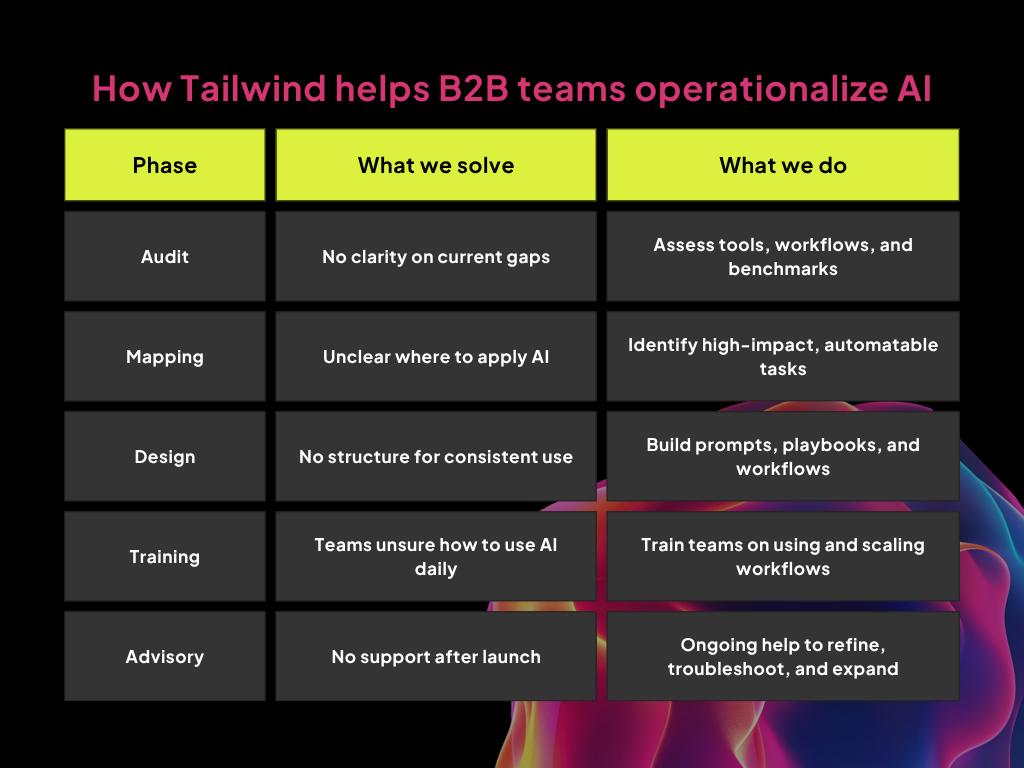AI adoption isn’t just about technology. It’s about people, processes, and priorities. For most B2B brands, integrating AI into marketing workflows presents a mix of promise and paralysis, where pilot projects spark interest but fail to scale, and internal excitement fizzles out due to unclear roadmaps or leadership misalignment.
In this blog, we unpack the most common roadblocks to AI adoption in B2B marketing and how brands can move from uncertainty to impact faster and with more confidence.
The 5 most cited roadblocks in AI adoption
1. Fear of the unknown (and of getting it wrong)
Teams often hesitate to engage with AI because they don’t fully understand its scope, risks, or implications. Will it replace jobs? Will it break existing systems? Is it even legal or ethical in our market?
What to do:
- Run AI literacy workshops for marketers.
- Build clarity with sandbox environments for safe experimentation.
- Establish internal AI policies and ethical guardrails early on.
2. Fragmented tools and data silos
AI systems require clean, connected data. But most B2B marketing teams are drowning in disjointed CRMs, email platforms, lead gen tools, and ad tech. Integrating AI into this fragmented setup leads to limited impact and even more complexity.
What to do:
- Conduct a tech audit to identify integration gaps.
- Invest in unifying data layers before layering AI tools.
- Prioritize platforms that offer native or API-based interoperability.
3. Lack of leadership buy-in
When leadership sees AI as a “nice-to-have” rather than a strategic enabler, adoption stalls at the pilot phase. Without C-level advocacy, AI efforts remain isolated experiments.
What to do:
- Quantify value: Use metrics from early experiments to showcase impact.
- Tie AI to core business goals—pipeline velocity, CAC, retention.
- Position AI as a competitive moat, not just a productivity tool.
4. No clear use case or playbook
AI sounds powerful, but if teams don’t know where to start, it leads to wheel-spinning. Without clear use cases, even the best tools fail to move the needle.
What to do:
- Start with high-friction, repeatable workflows (e.g., lead scoring, content repurposing, email personalization).
- Create internal playbooks that map tools to tasks.
- Benchmark against peer use cases within your industry.
5. Mismanaged transition
AI-driven workflows often demand new roles, rewired processes, and ongoing iteration. Without structured change management, teams revert to the old way of doing things.
What to do:
- Assign internal AI champions or task forces.
- Plan for training, onboarding, and ongoing optimization—not just deployment.
- Reward quick wins and internal success stories.
The role of strategic partners in de-risking AI adoption
B2B teams don’t need to figure everything out in-house. In fact, trying to do so often leads to over-engineered pilots or stunted deployments. Strategic partners help:
- Identify high-ROI use cases
- Design interoperable AI-native systems
- Ensure adoption through enablement, audits, and roadmaps
At Tailwind, we act as transformation enablers—building AI-driven marketing systems that integrate with how teams already work, while unlocking speed, consistency, and precision.
Conclusion: Don’t just adopt AI. Operationalize it.
The future of B2B marketing isn’t about using AI—it’s about building marketing systems that are AI-native by design. The real value lies not in dabbling but in integrating.
Tailwind helps B2B brands move from uncertainty to clarity—building systems where AI isn’t an add-on, but a strategic advantage.









